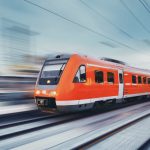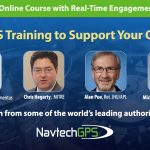Europe has been talking up its European Geostationary Navigation Overlay Service (EGNOS, for short) — and why shouldn’t it? Talking about Galileo doesn’t get satellites off the ground. EGNOS, on the other hand, is up and running, and has been since 2009. If the object is to build confidence in European savoir faire, why not talk about a real success like EGNOS?
Europe has been talking up its European Geostationary Navigation Overlay Service (EGNOS, for short) — and why shouldn’t it? Talking about Galileo doesn’t get satellites off the ground. EGNOS, on the other hand, is up and running, and has been since 2009. If the object is to build confidence in European savoir faire, why not talk about a real success like EGNOS?
As most Inside GNSS readers well know, EGNOS is Europe’s satellite-based augmentation system (SBAS), the equivalent of the U.S. GPS Wide Area Augmentation System (WAAS). EGNOS is fully operational, but still has some ground to cover in terms of its full exploitation, for example in the aviation sector.
While aviation may never be a big-time user of GNSS, at least measured in terms of absolute numbers of users or equipment sold, the impact of GNSS on commercial aviation (and thus the wider transport system and economy) is now seen as crucial.
And the emerging worldwide SBAS network, including EGNOS, WAAS, India’s GPS and GEO-augmented Navigation (GAGAN) system, and others, is central to making that GNSS impact real.
In a recent article co-written with Manfred Wittig, Norbert Frischauf of SpaceTec Capital Partners observes, “When it comes to approach and landing, the room for navigational errors becomes very small. At that point, airplane movements need to be controlled and coordinated tightly to ensure safety.
“But even if GNSS had the necessary accuracy, how can a pilot and airport tower know that the GNSS data is trustworthy, when ionospheric disturbances, clock drift, and satellite orbit errors can compromise a single satellite or the entire service?”
Thus, one of the key elements of the WAAS and EGNOS services is their integrity function, a sort of constant feedback loop to the user confirming that the navigation signal is reliable and can be trusted for safety-critical applications such as flight navigation and landings.
Upgrade Update
The value of SBAS is established, and there’s been a lot to say about EGNOS in particular in recent months. Last March, for example, the European Commission (EC) announced it had successfully launched two new-generation geostationary transponders – GEO-2 – on board the SES ASTRA 5B satellite from the European Space Port in Kourou, French Guiana, as part of its campaign to maintain and upgrade the EGNOS system.
The European GNSS Agency (GSA) says the new transponders will provide higher accuracy positioning signals to EGNOS-enabled receivers and ensure the continuity and quality of the EGNOS open service (OS) and safety-of-life (SoL) services for a long time.
Together with the previous transponder replenishment on the SES-5 satellite launched in July 2012, GEO-2 will soon be introduced in current EGNOS operations and will support the new EGNOS generation (EGNOS V3), which will provide dual-frequency signals on L1 and L5 bands and augment both GPS and Galileo.
New Face on the EGNOS Scene
On October 16 of last year, Matthias Petschke became the new director of the Galileo team of the European Commission. Asked to talk about the major challenges for EGNOS in 2014, he says, “Our focus is on the users of EGNOS services. This means two things: maintaining the excellent performance of EGNOS and expanding the EGNOS service area.”
About the new transponder launched last March, he says, “This transponder, which is of a new generation, will ensure the continuity of EGNOS open service and safety-of-life service for the next 15 years.
“Our second aim is to expand the service area of EGNOS safety-of-life service. Currently the SoL is not yet fully available in all 28 Member States of the European Union and coverage in southern, west, and eastern parts of Europe needs to be improved even more. At the same time, our objective is to increase the number of EGNOS-based approach procedures.”
Today Europe has almost 100 procedures using localizer precision with vertical guidance, Petschke points out and predicts that by the end of 2014, there will be at least 250 of them.
On the organizational level, he says, the challenge for 2014 is to put in place effective governance for the EGNOS program. “This means that the European Commission, having the overall responsibility for the EGNOS program, needs to put in place agreements with the European GNSS Agency and European Space Agency on implementation of the program over the next seven years.”
The European Union has allocated a budget of €1.58 billion (US$2.17 billion) to the EGNOS program for this period.
“On the technical side,” Petschke continues, “we are preparing deployment of a new EGNOS system release which should be operational by March 2015. Meanwhile, based on the current EGNOS system release the updated EGNOS services will be qualified and declared by the end of 2014, providing better performance for users.”
In September, he says, the GSA will present an EGNOS coverage extension plan for the EU member states territories geographically located in Europe, including Azores, the Canary Islands and Madeira. To increase the number of EGNOS approach procedures in airports the European GNSS Agency is working with the civil aviation industry, navigation services providers, airports, civil aviation authorities and co-funding research and development projects,” Petschke adds.
Bad Sun
Speaking to Inside GNSS at the recent Munich Satellite Navigation Summit (MSNS 2014), Ignacio Alcantarilla Medina, the EC’s deputy project manager for EGNOS, talked about the problem of ionospheric disturbances.
“This past February, we saw a peak in solar activities, meaning rising degradation of EGNOS signals in the north of Europe and the Canary Islands,” Alcantarilla said. The real impact in a case like this is at airports; one in particular, the Joensuu airport in eastern Finland, which, by the way, sits outside the area of committed EGNOS service delivery, was affected and was not able to fly using EGNOS.”
Back to Petschke, who says EGNOS users can expect increased robustness to ionosphere events beginning in 2014, “thanks to the new EGNOS system release deployed at the end of 2013. That means even greater availability of the service.”
“Also,” he adds, “two new EGNOS sensor stations are now qualified for operations in Agadir in Morocco and Abu Simbel in Egypt. They will help to increase EGNOS coverage in the South of Europe.”
Joining Petschke in the “new faces” list is Thierry Racaud, the new chief executive of the European Satellite Services Provider (ESSP), who took up his post in early 2014. ESSP is a private French company founded in 2009 by the air navigation service providers of France, Germany, Italy, Portugal, Spain, Switzerland, and the UK, which acts as EGNOS service provider.
We asked Racaud about ESSP’s main activities. “24/24 delivery of EGNOS services,” he replied, “as well as the operation and technical maintenance of EGNOS hardware and software systems, monitoring, analysis and reporting of EGNOS performance, promotion of the adoption of EGNOS services in all domains, e.g., aviation, maritime, road, agriculture, etc., and to support and interface with global navigation satellite system users and stakeholders.”
About the specific challenges for EGNOS in 2014, Racaud cited boosting the adoption of the EGNOS SoL service in aviation and investigating the use of SoL in other domains.
From a technical viewpoint, ESSP is preparing the deployment of a new EGNOS system release, which will improve the robustness towards ionosphere activity, of major importance for the northern countries, he added. The system release will also provide the LPV-200 service for aviation, introduce a new generation of geostationary satellite – ASTRA, and increase EGNOS coverage.
Racaud noted that new service definition documents for the EGNOS SoL and OS will also be published, to reflect the service improvements included in the recently deployed new EGNOS system release 2.3.2.
Racaud says the GSA is ESSP’s main customer and acts as the contract manager. Therefore, it seeks to maintain a constant and fluent relationship between the two parties. “The European Commission is the EGNOS program manager and owner, while ESA is the EGNOS design agent,” he says. “ESSP closely collaborates with ESA in the different system evolution activities.”
ESSP won the new, eight-year EGNOS service provision contract together with key partner Telespazio. Racaud says his agency is in regular contact with many European institutions, GNSS associations as well as industry partners: EUROCONTROL, EASA, Thales Alenia Space, GMV, and others.
Who Is Europe Competing with?
Americans (and others) are sometimes taken aback by the “competitive talk” that comes out of Europe in the context of GNSS.
For example, at the recent Munich Summit, Deborah Lawrence, the Federal Aviation Administration’s WAAS program manager, says she was jolted out of her jet lag when one European speaker stood up and declared, “Galileo is better than GPS!”
“Excuse me?” she reports having said to herself.
But that doesn’t mean committed cooperators like Lawrence are taking the bait.
“We are not in competition with anyone,” she told Inside GNSS. “We want to see a strong and efficient EGNOS. We do not want to see the EU making some of the same mistakes we made with WAAS; we want the Europeans to be able to learn from us. A good, operational EGNOS, and especially a dual-frequency EGNOS, is good for all of us, for the whole world.”
Striking a similar note, long-time GPS pioneer Brad Parkinson says, “We’ve got a track record with WAAS. We’ve got plenty of scar tissue in getting that thing running. The EU can look at that track record and learn from it, and we want to help them.”
We remind readers that the Directorate-General for Industry and Entrepreneurship is the EC unit in charge of Galileo and EGNOS; so, the apparent competitiveness may simply be the only way some European leaders know of to argue in defense of billions of euros invested in European GNSS.
GNSS now spans every area of our socioeconomic life, and a European GNSS is just as much a strategic interest for the region’s transport sector, space policy, health and emergency services, internal and external security, finance, and so on as GPS is for the United States, GLONASS for Russia, or BeiDou for China.
Building EGNOS and Galileo is going to give the European GNSS industry a leg up on the competition, so the story goes. The idea is that European developers will be there to come up with new and profitable applications aimed at exploiting the new capabilities made possible by Galileo and EGNOS.
Norbert Frischauf brings us back to earth: “As SBAS coverage areas grow larger and develop specific services for various markets, i.e., EGNOS open service, SoL, and EDAS, ensuring interoperability of the different systems becomes a main concern. With the advent of the L5 frequency band, WAAS, EGNOS and MSAS will start to form overlapping areas — by then interoperability will have become an absolute key word.”
Indeed, much of the discussion around SBAS in recent months has been all about convergence, “multi-constellationism”, cooperation and partnership, interoperability. We begin to see just how much Galileo and EGNOS are really only parts of an emerging global and fully interoperable system of systems that will be there for everyone to exploit, not just the Europeans.
Why will European entrepreneurs suddenly be more able to imagine new products and services and develop new income streams than they have in the past? Because Europe has put up a new global infrastructure that the whole world can use?
We know that Galileo per se is never directly going to make the billions it will take to pay back its investors — the European taxpayers. The success or failure in business terms — as the EU likes it — relies on whether or not EGNOS and Galileo can be the magic pill to stir European entrepreneurship and get the EU out of its long-standing economic doldrums.
We’d all like to see it happen, but we may have to see it before we believe it.
As a footnote, we also recognize the potential of European GNSS on the political football field. Some people “in the know” but “off the record” point out that EGNOS coverage of Ukraine may already be in the works, a budget line already written. Russia’s own SBAS, called System of Differential Correction and Monitoring or SDCM for short, is still being built. One would expect Russia’s intention is to provide coverage to Crimea, but not the Ukraine, whatever’s left of it, that is. How they intend to do so, in geographical terms, remains to be explained.






